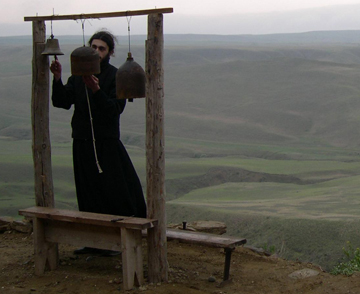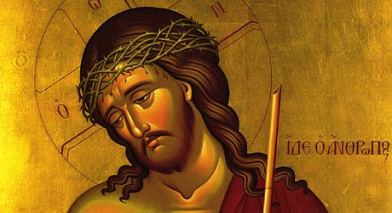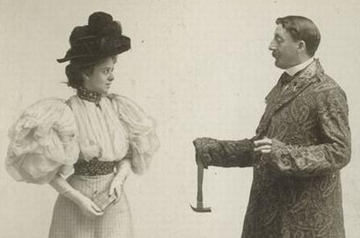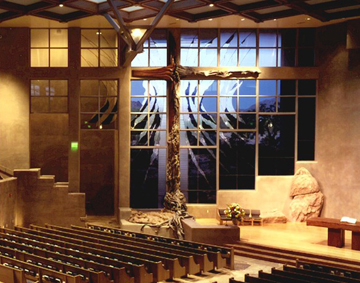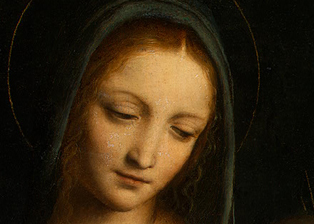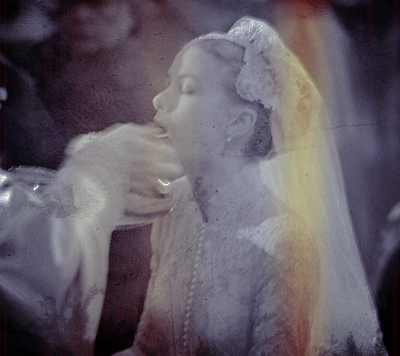 Or the Theology of the Soapbox
Or the Theology of the Soapbox
What follows in another one of my long expositions on the Theology of the Body. I have to give a loud content warning at the outset. There is some frank talk here about sexuality, or rather, my complaints that there is too much frank talk about such matters. I would have asked Dawn Eden to publish this one, but she has very courageously retired from blogging. I have to commend her on her decision; however, it is not without regret on my part.
I again want to let those I disagree with know that my intentions are honorable and I do not question their integrity or commitment to the faith. I can take my lumps if I deserve them.
In a recent apologia for Christopher West, Father Thomas Loya makes grand assertions:
Christopher West is a bit of a mystic—in the best sense of the word. His work, which seems strange to some, is actually that of a pioneer. And like all pioneers, West is taking a lot of arrows for his courage. In the face of much resistance, West is courageous enough to invite all of us to do just what John Paul II invited us to do: to think and talk in spousal categories.
He goes on to put the author and speaker in good company:
West’s use of this kind of imagery is rooted deeply in the Catholic tradition. Hence, if we want to condemn West for certain comparisons he makes, then it seems we must condemn a great many saints as well. St. John Chrysostom told married couples to remember that Christ united himself to the Church “in a spiritual intercourse.” Teresa of Avila writes of ecstasies she experienced in “nuptial union” with Christ. St. Bernard of Clairvaux had mystical experiences of nursing at Mary’s breasts. St. Louis de Montfort repeatedly refers to Mary’s milk and breasts as a source of consolation for Christians. Bishop Fulton Sheen – assuring his audience that he was quoting St. Augustine verbatim – proclaimed that Christ “came to the marriage bed of the Cross, … united himself with the woman [the Church], and consummated the union forever.” And he didn’t hesitate to share publicly Augustine’s idea that the blood and water from Christ’s side was, as it were, his “spiritual seminal fluid.” For those with eyes to see, these precious theological jewels are not a cause for scandal. They make perfect mystical sense; they are beautiful and profoundly healing.
No Mystics or Martyrs
In truth, these “precious theological jewels,” are not a cause for scandal, nor has anyone that I know of been scandalized by them. This is another straw man argument put forward in defense of Christopher West without addressing any of the real issues that have been raised by those who have problems with his presentation of TOB.
I know very well that there are many people who disagree with my analysis of the West/TOB issue. I do not claim to have any mystical insight, nor do I believe that anyone who disagrees with me is my persecutor, nor do I know of anyone else on my side of the issue who believes he or she is suffering the slings and arrows of defenders of West. Considering the influence West already has, I think it would be more productive if these elevations to mystic and martyr were dropped in favor of an effort to engage in a real intellectual discussion of the issues.
I do not know of anyone who has minimized the value of John Paul II’s presentation of the faith in “spousal categories,” nor anyone on my side of the issue who has criticized a saint. On the contrary, it is West who takes the saints to task for their alleged prudery. But let me comment on Father Loya’s saint references one by one.
Saintly Eroticism?
The context of St. John Chrysostom’s remark is a discussion about the holiness of marriage insofar as it was denied by heretics who themselves engaged in sexual depravity. It was not an exhortation to have a holy preoccupation with sex.
St. Theresa of Avila and other mystics, like St. Bernard, often comment on nuptial and erotic imagery of the Song of Songs, but this does not translate into the sexualization of their mystical experiences with Christ or into a constant preoccupation with the natural and holy pleasures of marriage, as I have pointed out elsewhere. If the contrary is true, I would like to see someone actually make a reasoned argument for the position, rather than simply assert that it is true because saints commented on the Song of Songs.
As for St. Bernard’s mystical experience and St. Louis’s de Monfort’s references to Maria Lactans, are West and Father Loya really suggesting that these experiences and meditations were sexually erotic? That assertion, quite frankly, would be blasphemous. If that is not what is meant, I would like to know what the correct interpretation is. (I have dealt specifically with West’s over-extended and flatly mistaken interpretation of St. Louis, elsewhere.) If grown men who have a natural and vehement sexual attraction to women find it difficult to have the same regard for a woman’s body as a nursing infant, I do not think this should be faulted them. Do you? It is no shame to admit that we are not St. Bernard.
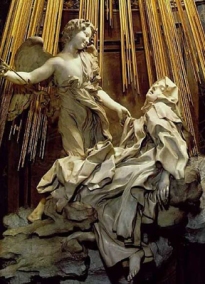 The quote of St. Augustine by Bishop Sheen is conveniently edited to exclude the statement of the saint that Christ came to “a bed of pain, not pleasure.” Father Loya has done this more than once, as I have learned from Dawn Eden. In any case, as much as I believe St. Augustine is scapegoated for modern prudery, I can hardly imagine the great doctor of the West preaching and teaching that we ought to have a holy preoccupation with sex.
The quote of St. Augustine by Bishop Sheen is conveniently edited to exclude the statement of the saint that Christ came to “a bed of pain, not pleasure.” Father Loya has done this more than once, as I have learned from Dawn Eden. In any case, as much as I believe St. Augustine is scapegoated for modern prudery, I can hardly imagine the great doctor of the West preaching and teaching that we ought to have a holy preoccupation with sex.
Since when does nuptial and erotic imagery in the bible and the writings of the saints translate into a constant, marketed, mystic and martyred fascination with sexuality? Since Christopher West has asserted it and suggested that those who doubt it need to look within themselves and ask why they are uncomfortable with thinking in this way. And now Loya plays the absolute moral authority card by declaring West mystic and martyr.
Pious Sex Obsession
Let us be clear: The real issue is not whether the Theology of the Body is an important contribution to the Church’s new evangelization, but whether as a single corpus of magisterial teaching it constitutes the new evangelization, and whether its valid interpretation is a mandate for a fascination with the erotic. I am willing to drop the veiled language only in the sense that we need to make plain that all this revisionist apologetics has become a pious justification for the contemporary obsession with sex.
Loya quotes John Paul II, where he says that “consciousness of the spousal meaning of the body constitutes the fundamental component of human existence the world” (TOB 15:5). But why are we supposed to believe that this mean that we must keep our minds focused on sex? And then Loya quotes the Holy Father again in Mulieris Dignitatem, where he says that “the Eucharist is the … sacrament of the Bridegroom and of the Bride” (26). But why are we to conclude, then, that the pope wants us to think sexual thoughts? John Paul II’s Theology of the body is so philosophical and dense that “experts” have succeeded in squeezing more out of the text than is warranted because they are very effective apologists and rhetoricians.
Manichaean Bogeyman
Father Loya has his own question which I am happy to answer once he clarifies if for me: “Could it be that those tainted by a Manichaean suspicion are actually projecting their own issues on to West?” And who would these persons “tainted by a Manichaean suspicion” be? Perhaps those who disagree with West, precisely because they disagree with him? This is a classic example of the fallacy of the complex question. So who is projecting?
Lest you think I exaggerate, lest you think that we are not being told to shed our inhibitions and get erotic, behold the language of Father Loya’s Holy Week meditation:
So, is your sex life improving? It should for those who have really understood and embraced the season of Lent. We said last time in this column that the season of Lent was great for our sexual lives. Now it gets even better!
. . . . The events of the week leading up to Christ’s death on the Cross are like a mystical “foreplay.” In fact, Jesus is even stripped naked during this process. What happens on the Cross is not just the death of Christ but the consummation of a mystical marriage between God and His Bride. This is why Christ looks down from the Cross at his mother and calls her “Woman.” He echoes the name Adam gave to Eve because in this climactic moment, Christ becomes the new Adam and his Mother becomes the new Eve.
. . . . This is why in my church we sing with great exuberance on the days of Pascha (EasterJ “Christ emerges from the tomb like a bridegroom from the bridal chamber and fills the women with great joy!” Wow! Now is that sexual or what!?
Lent is “mystical foreplay” And Holy Week the best part of our sex lives? No, the problem here is not that prudery reacts against something holy, but that common sense reacts against the vulgarization of something holy.
Sex Sells
But we are told this kind of language is necessary because people are deeply wounded in their sexuality and need to be talked to frankly about it. That is certainly a valid consideration. Good people will have to be free, within measure, to decide for themselves where the line ought to be drawn. My inclination is not to burden apologists by all kinds of secondary rules about what they may or may not say; however, a good argument does not justify a bad conclusion. I contend that a holy fascination with sexuality is not in any way mandated by John Paul II’s Theology of the Body.
The problem with marketing language designed for our oversexed age, is that it canonizes and intellectualizes the modern sex obsession. That objections to this are rooted in Manichaeism is a red herring, because the people claimed to be in most need of healing through TOB are those who already have little in the way of sexual inhibitions. Furthermore, the advance levels of indoctrination into this popularization of TOB are not less explicit, but more explicit. So the erotic preoccupation really has little if anything to do with apologetical exigencies.
Hermeneutic of Discontinuity
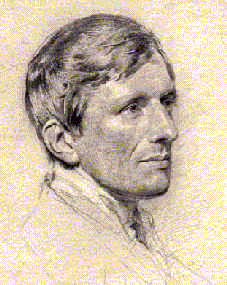 In fact, this sex fascination is based on a hermeneutic of discontinuity and is not a development of doctrine at all, because, as Newman would point out, its “action upon the past” is not “conservative.” That is, on the contrary, it “obscures,” not “illustrates”; corrects, not “corroborates,” “the body of thought from which it proceeds.” Thus, it is a corruption of doctrine, not a development. Any recourse to mystic intuitions in support of this kind of speculation or martyrdom when it is opposed just sinks the position further into fallacious argumentation.
In fact, this sex fascination is based on a hermeneutic of discontinuity and is not a development of doctrine at all, because, as Newman would point out, its “action upon the past” is not “conservative.” That is, on the contrary, it “obscures,” not “illustrates”; corrects, not “corroborates,” “the body of thought from which it proceeds.” Thus, it is a corruption of doctrine, not a development. Any recourse to mystic intuitions in support of this kind of speculation or martyrdom when it is opposed just sinks the position further into fallacious argumentation.
I do not oppose this with such vehemence because I dislike West or Loya, or because I am jealous (another really swift argument), but because the assertions I criticize are false. The topics being discussed are extraordinarily important. The more those who disagree with me call my part of the discussion foul play, the more I am convinced that what they espouse is harmful.
Mystery and Martyrdom
In fact, chastity is a mystic reality, precisely because it is the mystery of martyrdom. This is the doctrine of marriage, according to St. Paul, which teaches that marriage is a great mystery, precisely because the Bridegroom gave Himself up for the Bride (Eph 5: 32, 25). As John Paul II states:
The Church is herself in the degree to which she, as body, receives from Christ her head the whole gift of salvation a fruit of Christ’s love and of his giving for the Church: fruit of Christ’s giving to the end. The gift of self to the Father through obedience to the point of death (see Phil 2:8) is at the same time, according to Ephesians, an act of “giving himself for the Church.” In this expression, redeeming love transforms itself, I would say, into spousal love: by giving himself for the Church, with the same redeeming act, Christ united himself once and for all with her as Bridegroom to the Bride, as the husband with the wife, giving himself through all that is included once for all in “giving himself” for the Church (TOB 90.6).
“Redeeming love,” “spousal love,” “giving himself,” and “obedience to the point of death,” are all dimensions of the same love, the focus of which is oblative and sacrificial. Certainly erotic pleasure is related to sacrificial love as receiving is to giving, but even the theological meaning of giving of one’s body in Christian marriage is more about sacrifice than possession, more about selflessness than pleasure. Christ spousal love is the act of “giving himself” to his bride on the cross in the embrace of death. The paradox is that the keenest joy and pleasure, even in the marital embrace, is experienced when there is complete selflessness. The eros God intends for us is gained, not by focusing on it, but on agape.
This primacy of oblative love reveals the full context of St. Augustine’s remark, only selectively quoted by Father Loya:
The heavenly bridegroom left the heavenly chambers, with the presage of the nuptials before him. He came to the marriage bed of the cross, a bed not of pleasure, but of pain, united himself with the woman, and consummated the union forever. As it were, the blood and water that came from the side of Christ was the spiritual seminal fluid.
Pope Benedict XVI clarifies this in Deus Caritas Est when he calls the death of Christ on the cross “love in its most radical form,” from which “our definition of love must begin.” This “act of oblation” is given an “enduring presence” in the Eucharist through which we “are drawn into Jesus act of self-oblation (12, 13). The pope says:
The imagery of marriage between God and Israel is now realized in a way previously inconceivable: it had meant standing in God’s presence, but now it becomes union with God through sharing in Jesus’ self-gift, sharing in his body and blood. The sacramental “mysticism”, grounded in God’s condescension towards us, operates at a radically different level and lifts us to far greater heights than anything that any human mystical elevation could ever accomplish (13).
So yes, the Eucharist is “the sacrament of the Bridegroom and of the Bride,” but this statement is not a pretext for dwelling on the marital embrace. It is not holy eroticism. There is far too much in the world today that, a la Dan Brown, turns eroticism into piety and prayer. This is not the “sacramental mysticism” of the Church, but the “human mystical elevation” of the pagans whom the pope criticizes.
Let’s Talk Sex, Not
Lest I be misconstrued, I must refer once again to the context of my remarks, which is in no way determined by an antipathy toward erotic love, or by the machinations of the Manichaean demon. The fact is that John Paul II’s Theology of the Body is being used by others to justify a fascination with erotic love and the institutionalization of sex talk as the new evangelization. The pretext for this is the presumption that the absence of this kind of talk and discomfort with it is due to prudery.
Prudery is a problem, as I have attested many times before, but it is simply not true that prior the sexual revolution, Vatican II and John Paul II there was no mainstream corrective offered here in America by prominent Catholics. Dawn Eden has done some research on this subject and has discovered, for example, that in 1958 Msgr. George A. Kelly edited and published a highly successful and acclaimed manual on marriage that addressed prudery in very explicit terms.
Monsignor Kelly was prominent priest of the Archdiocese of New York, appointed by Cardinal Spellman to be Family Life Director in 1955, and who in 1977 founded the Fellowship of Catholic Scholars. Monsignor Kelly’s Catholic Marriage Manual “sold a quarter-million copies and netted him almost a quarter-million dollars in royalties, every penny of which went to the New York Foundling Hospital.” It received Cardinal Spellman’s imprimatur, and was highly and widely praised by members of the Catholic media and academia.
Chapter 3 of the manual was written by Bernard J. Pisani, M.D. and entitled “A Catholic Doctor Looks at Marriage.” There Dr. Pisani addressed prudery in no uncertain terms:
Since sex is God’s creation, it is presumptuous for any creature to call It “dirty” or “vulgar.” Yet misunderstanding of the goodness of sex when its use conforms with God’s law is the cause of many difficulties in marriage. These problems stem from the prevailing point of view of a century ago that the sex act was not “nice” under any circumstances. Sex was something shameful, a necessary evil that should be kept hidden from children as long as possible. Remnants of that puritanical point of view remain. Often a woman in her twenties, who is ready to enter matrimony, has the fixed notion taught by her parents that the act of physical love is an animal function which should be tolerated when necessary but never enjoyed. She has been warned since adolescence about the evils of sexual intercourse. Because of their own misunderstanding her parents were unable to draw the necessary distinction between the improper use of sex outside of marriage and its proper role inside marriage. They regard God’s creation as a necessary evil at best.
What is more noteworthy is that doctor Pisani addressed the question of “mutual climax” at more or less the same time that Karol Wojtyla was delivering his talks in Lublin that included the same notion. The written work Love and Responsibility did not appear until 1960 and was not published in English until 1981, twenty-three years after American Catholics had the opportunity to read these words of Dr. Pisani:
Since the typical male will reach a climax sooner than his wife unless he controls himself, he should learn to delay the peak of his excitement and to caress and stimulate his wife so that they achieve release in unison. Young brides especially should realize that the reaching of such an adjustment often requires considerable time. Because the act of sex is such an intimate activity, its enjoyment requires the gradual flowering of mutual understanding and a sense of freedom. The husband must learn to recognize his wife’s reactions at the various preliminary stages and to govern his own impulses accordingly. Satisfactory adjustment in the sense of simultaneous release may require many months or even years to achieve, and perhaps may never be achieved on a regular basis. You will help this adjustment if you discuss your relationship with love, frankness and an understanding of your partner’s fundamental nature and specific responses.
So much for West’s claim that the Holy Father was revolutionary on this point. And to think this was first put into print in the body-hating, sex-despising U.S. of A. The popular American interpretation of John Paul II’s Theology of the Body which at heart is a formula to overcome prudery is based on a myth that the Church had no effective means or even the awareness to address the problem. This is not to say that John Paul’s teaching is not a tremendous contribution, only that the American interpretation is based on a historical falsehood used to justify a hermeneutic of discontinuity.
One thing can be learned from the time in which prudery was being addressed by the Church without the “theological timebomb” that has become a pretext for focusing on the erotic: It is actually possible to address problems of sexuality and prudery without ripping down all the veils, vulgarizing our catechesis and making sure we train ourselves to look on nakedness without shame.
The Theology of Clothing
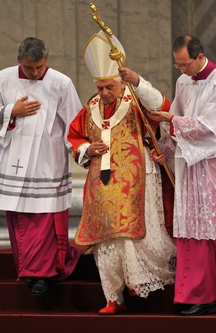 In fact, it seems that in 2000 Cardinal Ratzinger might have been offering a corrective when he dealt with the modern liturgical penchant for unveiling everything. He wrote that “the theology of clothing becomes a theology of the body.” His use of John Paul’s appellative for this modern corpus of teaching on marriage and sexuality cannot be coincidental.
In fact, it seems that in 2000 Cardinal Ratzinger might have been offering a corrective when he dealt with the modern liturgical penchant for unveiling everything. He wrote that “the theology of clothing becomes a theology of the body.” His use of John Paul’s appellative for this modern corpus of teaching on marriage and sexuality cannot be coincidental.
The context of Cardinal Ratzinger’s remarks on this topic in The Spirit of the Liturgy is his discussion of the meaning of priestly vestments, which signify, in the words of St. Paul, the clothing of our perishable nature in immortality (1 Cor 15:53). Though the context is different from our immediate concern, it is, in my opinion, at least analogous and validly applied to our topic. The Holy Father himself makes reference to the Theology of the Body and concludes his discussion with a reference to the clothing of the newly baptized in the white garment, which is “an expression of the purity and beauty of the risen Christ” (220). It is at least interesting that the new man in Christ, redeemed in body and soul, and incorporated into the body of Christ through Baptism, is not stripped but clothed. In any case, here is Cardinal Ratzinger at length:
Paul describes the body of this time as an “earthly tent”, which will be taken down, and looks ahead to the house not made with human hands, ‘eternal in the heavens’. He is anxious about the taking down of the tent, anxious about the ‘nakedness’ in which he will then find himself. His hope is to be not “unclothed”, but “further clothed”, to receive the “heavenly house” — the definitive body — as a new garment.
. . . Thus the theology of clothing becomes a theology of the body. . . . The liturgical vestment carries this message in itself. It is a “further clothing”, not an “unclothing”, and the liturgy guides us on the way to this “further clothing”, on the way to the body’s salvation in the risen body of Jesus Christ, which is the new “house not made with hands, eternal in the heavens” (2 Cor 5:1). The Body of Christ, which we receive in the Eucharist, to which we are united in the Eucharist (“one Body with him”, cf. 1 Cor. 6:12-20), saves us from “nakedness”, from the bareness in which we cannot stand before him (218).
Perhaps, the reason why John Paul II never went as far as to say that “sex is liturgical,” not even with qualifying words “in a sense,” (a phrase he often uses in TOB, as Steve Kellmeyer has pointed out) is because of the extremes to which men are inclined to go. Perhaps it had nothing to do with scandalizing the prudish, but with not encouraging those who are inclined to strip everything down to genitalia and sex acts.
The Reform of the Reform
Is not what the pope has called the “reform of the reform” a measured reaction against the vulgarity by which every boundary and veil has been penetrated and every sanctuary violated. We no longer even have sanctuaries, we have unveiled, boundariless “worship spaces.” Even Catholic liturgical orthodoxy is presented to us in such a way that we are forced to watch the Easter Candle copulate with the Baptismal font. I am not going to mince words here. I have been criticized for not using “nuptial’ language in reference to this groundless assertion. When is it ever appropriate or even moral to simulate a sex act in public (or even in private for that matter), let alone during the sacred liturgy? Never. We fittingly modify the description of such acts with the word “pornographic.” It is only the skills of the rhetorician that has allowed this travesty to pass for liturgical interpretation.
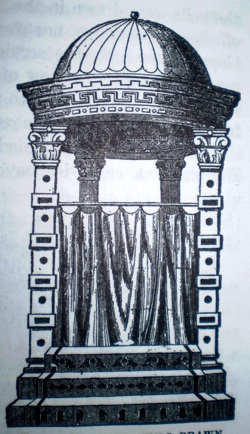 Or we are told that the Baldichin covering the altar of sacrifice is a bed canopy, because, by all means we need to think about a man and woman having sex on the altar when the Sacrifice of Christ is being offered during the Holy Mass. But, in fact, isn’t a bed canopy a kind of veil, a boundary that creates a sacred space in which “liturgy” of marriage takes place and in which the revelation and communion is experienced by the two spouses alone? In fact as we learn from the New Liturgical Movement blog, the Baldichin is traced back to the ancient ciborium mangum, the veils of which were actually drawn closed during parts of the sacred liturgy. There is no question that the liturgy is replete with “spousal” and “nuptial” imagery, as are the scriptures and the writings of the saints, but I take exception to Father Loya’s hijacking of these terms, by suggesting that healthy Catholics see the erotic everywhere.
Or we are told that the Baldichin covering the altar of sacrifice is a bed canopy, because, by all means we need to think about a man and woman having sex on the altar when the Sacrifice of Christ is being offered during the Holy Mass. But, in fact, isn’t a bed canopy a kind of veil, a boundary that creates a sacred space in which “liturgy” of marriage takes place and in which the revelation and communion is experienced by the two spouses alone? In fact as we learn from the New Liturgical Movement blog, the Baldichin is traced back to the ancient ciborium mangum, the veils of which were actually drawn closed during parts of the sacred liturgy. There is no question that the liturgy is replete with “spousal” and “nuptial” imagery, as are the scriptures and the writings of the saints, but I take exception to Father Loya’s hijacking of these terms, by suggesting that healthy Catholics see the erotic everywhere.
In fact, the language of the liturgy envelopes the mysteries we celebrate in a sacred clothing. “Holy” means “other,” and times, places and activities are sacralized (made holy) by setting them apart, not by stripping them naked. Husbands and wives should absolutely rejoice in each others’ bodies and in their embrace which is blessed and hallowed by the Church. This is not even an issue. Furthermore, an exalted view of sexuality should be a means of healing us of the wounds of our disordered sexuality, but this voyeuristic enthusiasm for nakedness is not the proclamation of the holy, on the contrary is the vulgarization of the holy.
The liturgical boundary most often violated in this age of the sexual revolution and crusade against prudery has been the line that delineates the nave of the Church from the sanctuary, or the congregation from the place of sacrifice. There used to be an altar rail marking that separation, where the rule was reverence and awe of mystery. In even earlier times, there was the chancel screen or rood screen which obscured the altar of sacrifice and shrouded it in mystery. Eamon Duffy, in his monumental The Stripping of the Altars, writes that rood screen in medieval England and the veil which was added to it on the weekdays of Lent, did not, contrary most common assumptions, prevent the faithful from fully participating in the liturgy. The screen was not a wall, but a window that framed the “liturgical drama.” In this way, the people where able to penetrate the mystery, and at times the mystery would come to them when the ministers would come out carrying sacred objects, especially, at Easter time, when the priest would carry the Sacred Host itself before the screen (111-112).
The purpose of the veil, Duffy says,
“was to function as a temporary ritual deprivation of the sight of the sacring. Its symbolic effectiveness derived from the fact that it obscured for a time something which was normally accessible; in the process it heightened the value of the spectacle it temporarily concealed (111).
No one is saying that clothes should not come off at times. But those who reveal themselves, those to whom they reveal themselves, and the time, place and manner of the revelation need to be sacralized, not vulgarized. It is interesting to note also that in the tradition of the Roman Rite the tabernacle veil is ordinarily the first sign that the Eucharist is present in the tabernacle. Our Lord is reposed behind the veil and at the sacred hour and within the sacrificial space He comes to His people.
 In the East, this custom of veiling the sanctuary is retained in a fuller form by means of the iconostasis. In the Syriac Church the sanctuary is still completely veiled.
In the East, this custom of veiling the sanctuary is retained in a fuller form by means of the iconostasis. In the Syriac Church the sanctuary is still completely veiled.
My point is not to argue for a return to the screen, though I believe the elimination of the altar rail has at the very least sent the wrong signal; my point is merely to say that if marriage and sexuality have, “in a sense,” a liturgical dimension, and if the language of the liturgy is nuptial, then it is simply a non sequitur to claim that unveiling every liturgical and nuptial reality is a virtue. More to the point perhaps is the suggestion of Cardinal Ratzinger that the Eucharistic Canon ought to return to a more silent form. Silence is a form of veiling. It is certainly appropriate to be silent when to say something would only be to vulgarize a mystery. Much can be learned from St. John Chrysostom of this silence, which, as I know all too well, has been ignored in the most sterilely clinical and irreverent ways:
Since this heavenly birth cannot be described, neither does His coming amongst us in these days permit of too curious scrutiny. Though I know that a Virgin this day gave birth, and I believe that God was begotten before all time, yet the manner of this generation I have learned to venerate in silence and I accept that this is not to be probed too curiously with wordy speech. For with God we look not for the order of nature, but rest our faith in the power of Him who works.
In any case the greater availability of the Extraordinary Form of the Mass might contribute something positive to this needed dialogue of silence and sacrality.
Don’t You Dare Touch that Loincloth
West and company want a clear view of everything and they want to talk about it, and talk about it, and talk about it. Even the loincloth on Our Lord, they have said, is a necessary evil. We just can’t handle looking at Our Lord’s nakedness, but that is the real shame, they say. We are told that His nakedness on the Cross is a revelation.
Actually, it is a shameful thing. When our Lord revealed himself in glory on Mount Tabor, he was not stripped. It was his face that did shine as the sun, and his garment that became white as snow (Mt 17:2). He did not reveal his nakedness; He revealed the light emanating from the veil of His clothing. No, we were the ones who exposed His nakedness. We, the blasphemers and ingrates, stripped him naked, raised him on a gibbet and mocked him.
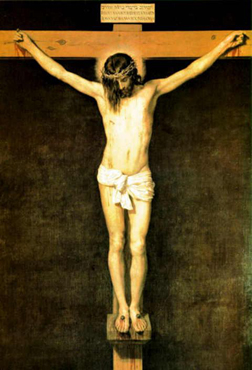 There is no question that in this Jesus fulfills the Old Testament typology as the New Adam, who recreates us in the nakedness of the Cross. But was it without shame? To recreate us Our Blessed Lord was made a curse for us. It is a shameful thing to be stripped and crucified before a jeering mob, and a curse to be hung on a tree (Heb 12:2; Gal 3:13). The typological correspondence doesn’t mean that we should dare to be so bold as to stare at Our Lord’s nakedness. It means that the nakedness imposed on Him shamefully is the sign of our restoration to grace, and the hope of the redemption of our bodies. Where does John Paul II tell us that the Theology of the Body means we should be focused on the erotic, even to the point of wishing to strip Our Blessed Savior naked? This is truly shameful.
There is no question that in this Jesus fulfills the Old Testament typology as the New Adam, who recreates us in the nakedness of the Cross. But was it without shame? To recreate us Our Blessed Lord was made a curse for us. It is a shameful thing to be stripped and crucified before a jeering mob, and a curse to be hung on a tree (Heb 12:2; Gal 3:13). The typological correspondence doesn’t mean that we should dare to be so bold as to stare at Our Lord’s nakedness. It means that the nakedness imposed on Him shamefully is the sign of our restoration to grace, and the hope of the redemption of our bodies. Where does John Paul II tell us that the Theology of the Body means we should be focused on the erotic, even to the point of wishing to strip Our Blessed Savior naked? This is truly shameful.
Peril and Martyrdom
In 1927 G. K. Chesterton delivered lucid address entitled Culture and the Coming Peril. “Vulgarity” was the term he used to describe the peril into which culture was falling. He defined vulgarity in relation to culture as “standardization at a lower standard.” He said:
The kind of thing that I mean is a certain large and gross familiarity, not always with bad but often with very good things, a familiarity that indicates insensibility to the thing that the man is handling.
It is certainly not to be suggested that Christopher West and company are insensible to the beauty of human sexuality, nor, in many respects, are the points that he makes to wounded souls without real merit; however, sexuality is of such a nature, like the liturgy, that constant analysis and drummed-up enthusiasm only vacates the mystery and the sacrality, no matter how exalted and good the object of our gaze is proclaimed to be.
I find it more and more difficult to take seriously the proposal that our real problem is Manichaeism. Not in this age where states are now finding it necessary to institute laws against the sexting of minor children; not in this age of the sterile voyeurism of the Facebook and Twitter culture, in which we have cultivated and refined the art of exhibitionism. I cannot tell you of all the instances in which I encounter tremendous heartache, useless drama, unproductive preoccupation and morbid self-loathing as a result of “too much information.”
No, the good news about human sexuality does not have to be expressed in more and more sex talk. The truth is that are not we really afraid of eros. We are afraid of agape.
Too many men, even Catholic men, define their masculinity in terms of libido, and too many women have either chosen to use their sexuality as a form of manipulation, or have otherwise consented to have foisted upon them a bill of goods that turns sexuality into spirituality. Yes, the cross and the liturgy are the places where the nuptial realities are consummated, and eros is the gift of that consummation, but we are kidding ourselves if we think we are going to ride our way to holiness on a bed of pleasure.
Posted in Blessed Virgin Mary, Catholicism, Family, Fatherhood, Feminism, Heroes, Husbands, Knights, Manliness, Marian Chivalry, Marriage, Men, Motherhood, Mothers, Pro-Life, Religion, Spirituality, Wives Tagged: agape, Baldichin, Benedict XVI, Bernard J. Pisani, Cardinal Ratzinger, Christopher West, Crucifix, Dawn Eden, Deus Caritas Est, Eamon Duffy, eros, Father Thomas Loya, G.K. Chesterton, Hermeneutic of Continuity, Human Sexuality, Iconostasis, John Henry Newman, John Paul II, Karol Wojtyla, Loincloth, Martyrs, Msgr. George A. Kelly, Mystics, Prudery, Reform of the Reform, Rood Screen, Soapbox, St. Augustine, St. Bernard of Clairvaux, St. Louis de Montfort, St. Theresa of Avila, Theology of the Body, Vatican II, Veil



